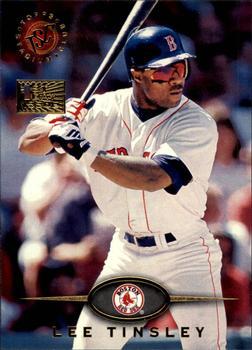Lee Tinsley and His Career Year Led to the Sox to Their 2004 World Championship (In Memoriam)
I was greatly saddened to learn that former Red Sox baseball player Lee Tinsley passed away at just 53 years old. Sadly, no cause of death was ever confirmed. As I’d already been writing up an article about Tinsley’s trade tree, this took priority with the sad news.
Lee Tinsley is one of the most important players in Boston Red Sox baseball history. The outfielder is part of one of the best trade trees the Red Sox have ever had. Tinsley was a key member of a trade that netted the Sox closer Heathcliff Slocumb from the Philadelphia Phillies. Even better for the Red Sox, Tinsley would return to the Red Sox the very next season in a trade! Then, as longtime Sox fans will know, Heathcliff Slocumb would be the headliner in a trade for a young starting pitcher and a young catching prospect.
If you weren’t following baseball in 1987, the year this author was born, you may not remember that Lee Tinsley was actually the 11th overall pick in the 1987 amateur draft. He was chosen by the Oakland Athletics. In 1991, Tinsley would be traded to the Cleveland Indians for former star infielder Brook Jacoby. This trade didn’t work out for Oakland, but it didn’t for the Indians, either. The Mariners would claim Tinsley off of waivers in September of 1992.
Tinsley would make his Major League debut in 1993, but collect just 3 hits in 19 at-bats. During Spring Training in 1994, Tinsley was traded to the Boston Red Sox for a player to be named later. That PTBNL would be pitcher Tim Smith, who never made the Majors. In fact, he never pitched again after the trade. Tinsley wouldn’t hit at all in 1994 for the Sox, slashing a miserable .222/.315/.292. But, the former first-round pick was known for his excellent outfield defense and base-running abilities, and he didn’t disappoint in either category. On the bases, Tinsley stole 13 bases and was never caught once. In the field, he was also worth +8 runs according to Total Zone. In all, Tinsley was worth 0.5 WAR.

After the player’s strike ended the 1994 season, Tinsley apparently went home and figured something out with his batting because his 1995 season would be his best ever. In 100 games in 1995, Tinsley slashed a very respectable .284/.359/.402 with a career best 7 HR and 41 RBI. He also stole 18 bases against 8 times caught stealing. While this meant he may have actually cost the Red Sox runs with that 69 percent success rate, he made up for that by continuing to take extra bases on balls in play. He was worth +2 runs above average on the bases. Again, he was excellent in the field, being worth 11 runs above average between center field and left field. While Tinsley’s batting was barely league average, his exploits in the field and on the bases made him worth 2.8 WAR. That’s exceptional for a fourth outfielder that cost the Red Sox almost literally nothing.
The Red Sox were quite pleased with Tinsley’s exploits, but decided to sell high on him. In retrospect, this was actually not a bad idea, but it wouldn’t really work out for the Sox at first. In January 1996, they packaged him with minor league outfielder Glenn Murray and relief pitcher Ken Ryan for the Phillies’ Heathcliff Slocumb. While Ryan would have an excellent year in the Phil’s bullpen, so would Slocumb who would post 3.1 WAR in 1996 for the Sox. Murray would only get into a few games for the Phillies in 1996 and never appear in the Majors again. So, this trade seemed like a decent win for the Sox, depending on how Tinsley did.
Unfortunately for Tinsley, whatever worked for him in 1995 didn’t carry over to 1996. His bat fell off a cliff. In just 31 games, and only 57 plate appearances, Tinsley “batted” .135/.196/.135 with no extra base hits. He stole 2 bases, but was caught 4 times, a ghastly 25 percent success rate. Even his fielding became below average, costing the Phillies an estimated 2 runs in just those 31 games. According to WAR, Tinsley was “worth” a negative 1.1 WAR. Meanwhile, Ken Ryan’s bullpen excellence was worth a solid 2.3 WAR for the Sox. If the story ended here, it would’ve been a huge win for the Red Sox.
However, the Red Sox admiration of Lee Tinsley was not over. In fact, in June, with the Red Sox struggling, they decided to take Tinsley off the Phillies’ hands for a minor leaguer, one who would never make the Majors. The thought was the change in scenery would get Tinsley back on track. This move backfired terribly for the Sox. In 92 games, Tinsley managed just a .245/.298/.333 line in 209 plate appearances. He was barely average in the outfield and continued to be a liability on the base paths, stealing 6 bases but being caught 8 times for a horrid 43 percent success rate. The total package was “worth” negative 0.6 WAR. It didn’t negate the gains from Slocumb, however.
So, with the Red Sox still ahead in the Lee Tinsley trade tree, they sent Tinsley back to the Mariners after the 1996 season. Interestingly, this would not be the only trade the Red Sox would make with the Mariners in the near future. In fact, it would involve the key man in the Tinsley trade from January 1996: Heathcliff Slocumb. Oddly enough, Slocumb actually pitched horribly for the Red Sox in 1997, pitching to a lousy 5.79 ERA in 27 games blowing 5 saves in his 22 chances.
At the trade deadline in 1997, July 31st, Slocumb would blow his 5th save and pitch his last game for the Red Sox. With a losing record of 51-57, the Sox cut ties with their closer. The Mariners were a playoff-bound team who needed to shore up the back end of their bullpen. In exchange for Slocumb, the Mariners shipped off a swingman with just 53 innings under his belt and a catcher who was still in Triple-A. The pitcher would pitch in 16 innings of 3.38 ERA ball in September for the Red Sox and the catcher would single in his only plate appearance of 1997. Their names were Derek Lowe and Jason Varitek.
Lowe would become a versatile swing man over the next few seasons who later evolved into a shutdown starting pitcher. The catcher would eventually wear C on his uniform, shove Alex Rodriguez in the face ,and win two World Series with Boston. Lowe would accumulate 19.4 WAR over 7 plus seasons. Varitek would compile 24.2 WAR over a 15 year career all with Boston. Had the Red Sox not traded Lee Tinsley for Heathcliff Slocumb, they never would’ve had two of their best players of the late 90’s and early 2000’s.
How did Slocumb do? He actually pitched fine down the stretch, converting 10 of 11 save opportunities, and pitched OK in his two postseason games. But, in 1998, he was demoted to a set-up man role and imploded again. They cut their losses and Slocumb would only have a couple more stretches of usefulness before being out of MLB in 2000.
As for Lee Tinsley, the 1997 season with the Mariners would be his last in MLB. He again hit lousy: .197/.263/.279. However, he didn’t cost the Mariners any runs on the bases and once again was a positive in the field, at a +8 runs clip in just 49 games according to Total Zone. So, at least Tinsley finished his major league career as a positive, albeit a 0.1 WAR positive.
Tinsley wasn’t out of baseball for a few more years, though. In 1998 he caught on with the Angels, who actually started him out at Double-A Midland in the Texas League. He hit .262 in 44 at-bats, enough for the Angels to move him up to Triple-A, where he again struggled. After being released by the Angels, he caught on with the Expos and their Ottawa Triple-A team. He didn’t hit well at all, but stole 13 bases against only two times caught stealing. So, he was still a useful role player, albeit as Triple-A depth.
In 1999, however, Tinsley joined the Mexican League with the Acereros de Monclova. With them, he actually found his 1995 form, hitting .305/.450/.441 with 3 HR in 43 games. It was enough for the Cincinnati Reds to take a flier on him, but he struggled yet again in 30 games. In 2000, Tinsley would finish his professional baseball playing career in 2000 with the independent Western League. It was a nice swan song for him, batting .379/.462/.551 in 56 games with 6 HR and 11 steals. After their short season, Tinsley rejoined Monclova and hit fine: .292/.365/.482 with 8 HR, although he’d finish the season with a different team in Tabasco who he only hit .040 in 8 games. It was a sad end to an otherwise great season.
That wasn’t all she wrote for Tinsley in baseball, however. In 2001, he joined the Arizona Diamondbacks as a hitting coach at Double-A. After a short stint with the Angels as a roving instructor in 2002, he returned to the Diamondbacks in 2003 as a minor league outfield coordinator. Eventually, Tinsley made his way back to the Majors as a coach, serving as the Major League 1st base coach from 2006 to 2008. After the 2008 season, he joined the Mariners coaching staff as first base coach for 2009 and 2010. After being a minor league coordinator for the Cubs in 2011 through 2013, he was an assistant hitting coach for the Cincinnati Reds in 2014 and 2015.
Since leaving the Reds, according to his LinkedIn profile, Tinsley bounced between part time private hitting, base-running, and fielding instructor, and working for FedEX and UPS in Phoenix, Arizona. Clearly, Tinsley didn’t lose his passion for baseball and has likely been a part of the development of many Major League Baseball players. But, the Boston Red Sox may have gained the most of any of these organizations, thanks to their extremely fortuitous acquisition of Heathcliff Slocumb who turned into two very good ballplayers who helped the Red Sox win the 2004 World Series.
Sure, many first-round picks never panned out. While Tinsley may never have become the hitter that his 1995 season promised, he was certainly a positive in the field and on the bases for the majority of his career. That experience has likely helped many current ballplayers through his coaching. It may not have been a famous baseball career, but it was certainly a productive one for Lee Tinsley. For Red Sox fans, his 1995 season should never be forgotten.
Rest in peace, Lee.
~ Amelia <3








RECENT COMMENTS